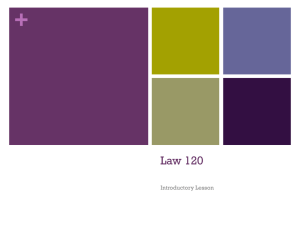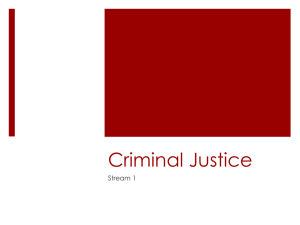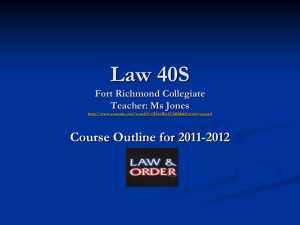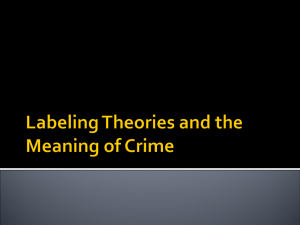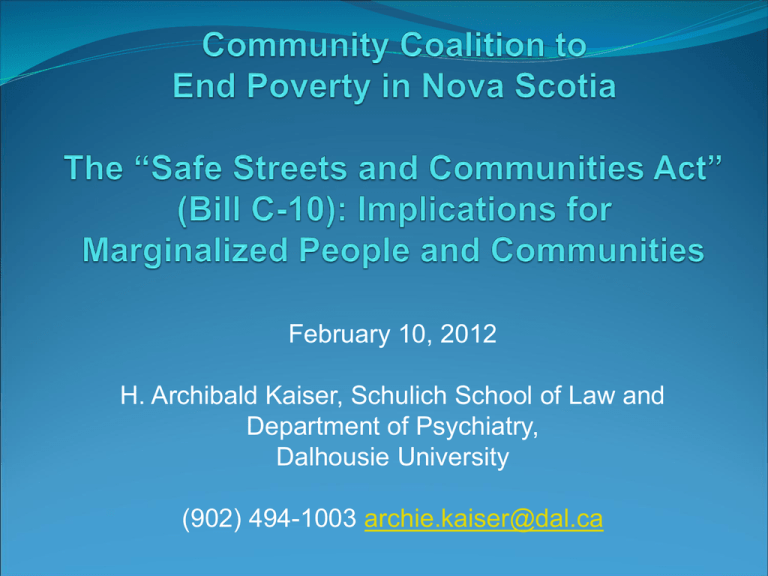
February 10, 2012
H. Archibald Kaiser, Schulich School of Law and
Department of Psychiatry,
Dalhousie University
(902) 494-1003 archie.kaiser@dal.ca
Outline of Presentation
• What Does Bill C-10 Do?
• The Government’s Position: “one step closer to cracking down”
• Overall Effects of the Legislation
• Positions of Professional Associations
• The Canadian Bar Association
• The Canadian Psychiatric Association
• The Canadian Association of Social Workers
• The Canadian Psychological Association
• The Canadian Pediatric Society
• The National Union of Public and General Employees
• Alternatives to Current Criminal Justice Policy
• Conclusion
2
What Is Bill C-10?
• A 208 section omnibus criminal “reform” Bill
• Combines changes from 9 bills as the Safe Streets and Communities Act
• Bill C-10 was passed at the House of Commons on December 5, 2011
• The Bill is now before the Standing Senate Committee on Legal and
Constitutional Affairs
3
What Does Bill C-10 Do? (from the Bill Summary, with supplements)
• Part 1, The Justice for Victims of Terrorism Act
• Creates “a cause of action that allows victims of terrorism to sue
perpetrators and their supporters” in Canadian courts
Preventing “a listed foreign state from claiming immunity”
This Part of the Bill is the most likely to be amended, although it
will have little practical effect on marginalized communities
4
Part 2 amends the Criminal Code of Canada
a) increases or imposes mandatory minimum penalties and maximum
penalties for certain child sexual offences;
b) creates offences of making sexually explicit material available to a
child and of agreeing to commit a sexual offence against a child;
c) expands the list of conditions for prohibition and recognizance
orders to prohibit contact with young persons and use of the internet
d) expanding the offences giving rise to these orders
e) further restricting the availability of conditional sentences of
imprisonment
5
• Part 2 also amends the Controlled Drug and Substances Act
• Provides minimum penalties for certain drug offences
• Increases the maximum penalty for marijuana production
• Reschedules certain substances to more serious classifications
6
• Part 3 amends the Corrections and Conditional Release Act (CCRA)
• clarifies that the protection of society is the paramount consideration
for the CSC, NPB and provincial parole boards by amending s. 3.1 of
the CCRA
• Eliminates reference in s. 4 of the CCRA to the least restrictive
principle
• Does not commit the Correctional Service of Canada to the protection
of the human rights of inmates
• Establishes the right to make victim impact statements at parole
hearings, with information disclosure to victims
• Automatic suspension of parole or statutory release in some cases
7
• Part 3 amends the Criminal Records Act
• Substitutes the term “record suspension” for “pardon”
• Extends ineligibility periods before which offenders cannot apply and
excludes some offences
• Will reduce the availability of record suspensions
• Part 3 amends the International Transfer of Offenders Act
• Stating a purpose is to enhance public safety and modify factors for
the PSEP Minister to consider
8
• Part 4 amends the Youth Criminal Justice Act
• Sentencing and general principles
• Amendments to s. 3(1)(a) emphasize public protection through
accountability
• Amends some provisions relating to judicial interim release,
sentencing, publication bans and placement in custody
• Increases the availability of adult sentencing
• Amendments will tend to increase detention before sentencing and
the duration of custodial sentences as well
9
• Part 5 amends the Immigration and Refugee Protection Act
• Permits refusal of work permits for foreign nationals, where to do
so would be contrary to specified policy considerations
• Other Acts are also amended in consequence
10
The Government’s Position: “one step closer to cracking down”
• “a fundamental pillar of our commitment to victims of crime”
• “meeting high expectations of Canadians”
• “law-and-order bills we have passed are undoubtedly having a
positive impact on reducing crime”
• Demonstrating Government’s “commitment to ensuring criminals are
held fully accountable … and that the safety and security of lawabiding Canadians and victims come first” (Minister’s News
Release, September 20, 2011
• “For over 40 years, Canada’s criminal justice system was pulled in
the wrong direction, focusing more on the rights of criminals than
victims. Our government took action to right this wrong -and we’ve
delivered.” CPC website, December 1, 2011
• “Bill C-10 is a bill for which Canadians have asked … Our
government believes in standing up for victims … our streets and
communities will be safer.” (Candace Hoeppner, M.P., February 7,
2012)
11
Overall Effects of the Legislation
• There will be more young people and adults in custody for longer periods
• Judges will have less discretion to ensure that sentences are carefully
tailored to the individual and his/her actual offence
• Judges will be obliged to send more people to prison and will have less
flexibility to impose non-custodial sentences and custodial sentences to
be served in the community
• The stigma following a criminal conviction will be harder to reduce or
erase and community reintegration will be more difficult
• Prisons will become more overcrowded and more mentally unhealthy
environments
• Attention will be diverted away from effective crime prevention strategies
• As treatment and prevention are deemphasized and prisons deteriorate,
communities will be less safe
12
13
14
15
16
Positions of Professional Associations
The Canadian Bar Association Position (C.B.A.) (November 17, 2011)
• “ironic name” given Canada’s having “some of safest streets” and “a
declining crime rate”
• “overreach and overreaction to imaginary problems”
• “could easily make it worse”
• “requires new prisons” when other jurisdictions have changed course
• “a mistake and setback”
17
The C.B.A. Position (continued)
• 1: ignores reality of actual crime reducing strategies: child poverty;
services for persons with mental illness; diversion of youth; rehabilitating
prisoners
• 2: “rushed through Parliament”
• 3: marketing approach of Government “ensures that its public support is
based heavily on inaccuracies”
• 4: inadequate study by Parliamentary committee
• 5: more young people will spend more remand time before trial
18
The C.B.A. Position (continued)
• 6: “eliminates conditional sentences for minor and property offenders”
• 7: “force judges to incarcerate people” who should not be in custody;
prisoners’ human rights will be disregarded
• 8: “justice system overload” “Where the justice system already at the
breaking point”
• 9: : “Victimizing the most vulnerable”, especially for Aboriginal
people
• 10: “no way to responsibly decide the bill’s financial implications”
19
The C.B.A. Position (continued)
• “a
huge step backwards”
• Does not prioritize public safety
• “emphasizes retribution above all else”
• “make us less safe, less secure, and ultimately, less Canadian”
20
The Canadian Psychiatric Association
• Bill C-10 will dramatically increase the number of incarcerated
individuals in Canada
• “Just like current prison populations, these people will experience
mental illnesses at disproportionately high rates”
• Without “a robust mental health strategy with its aggressive stance
on justice policy the mental health crisis in our prisons will
worsen” (News Release, December 7, 2011)
21
Canadian Association of Social Workers
• Asks the government “to balance crime and punishments with a
rehabilitation agenda”
• “front line experience with poverty, crime, and victimization
contradicts the direction C-10 is taking”
• “results expected from C-10 are drastically different than intended”
• “more convicted criminals in jail … costs of higher prison
populations … cost to society in lost opportunities for rehabilitation”
(News Release, November 7, 2011)
22
Canadian Psychological Association
• “Mandatory Minimum Sentences” (MMS)
• “are expensive”; “small effect on public safety in comparison to
alternative methods (e.g. treatment of the highest risk offenders) that
are more likely to reduce crime”
• “do not reduce crime”; “neither stop people from committing the
crime nor from committing additional crimes”
• “are unjust”; “have resulted in the breakdown of the criminal justice
system”; “justice is weighted in the hands of the police” and
prosecutors, not “judges who have been trained in the administration
of justice”
23
Canadian Psychological Association (continued)
• New or Amended Sexual Offences Involving Children
• “majority of children are victimized by adults they know”, not
strangers
• “sex offender registries do not have an impact on recidivism rates”
• There are differences between online only offenders and those who
want to meet “a minor in real life”
• “For adolescents”, should be a “legal distinction between poor
judgment and criminal content” relating to “sexually explicit images”
24
Canadian Psychological Association (continued)
Treatment Versus Incarceration
• C-10 will put “more people in jail for longer periods of time”
• “incarceration does not reduce crime”; “treatment works”
• Should instead “concentrate on moderate and high risk offenders,
target changeable risk factors … incorporate proven, human services
… as part of offender rehabilitation” (CPA Submission to the Senate,
January 30, 2012)
25
The Canadian Pediatric Society
• Opposed to the amendments to the Youth Criminal Justice Act
• “deeply concerned abut the negative effects on the developmental
•
•
•
•
and emotional health of young offenders”
“respect the UN Convention on the Rights of the Child”
• “Children should not be put in prison with adults”
“federal government should … establish a national youth crime
prevention strategy”
“Youth convicted of a crime and incarcerated should be provided
developmentally-appropriate mental and physical health care, as well
as rehabilitation and educational services”
“amendments to the Youth Criminal Justice Act must consider the rights
of youth and their mental, physical, developmental, and educational
needs” (CPA Position Statement AH 2011-02, June 2011)
26
The National Union of Public and General Employees
• A Union representing corrections officers
• “The new legislation ignores the growing mental health crisis
•
•
•
•
facing jails across the country”
“new drug sentences alone will see a dramatic increase in the
number of offenders in already overcrowded correctional
facilities”
“it will not make our communities safer”
“contrary to the pragmatic and compassionate approach to
criminal justice in which Canadians pride themselves” (NUPGE,
November 9, 2011)
“When people talk about Harper being tough on crime, I think Bill
C-10 demonstrates that the Harper government is dumb on crime.”
(James Clancy, NUPGE President, CBC, Jan. 26, 2012)
27
Alternatives to Current Criminal Justice Policy
• See Fearmonger, by Paula Mallea (Lorimer: Toronto, 2011)
• “Poverty is a risk factor”
• Crime prevention programs; “community-building” (153)
• “aimed at youth”;
• “target local issues in sensitive and culturally appropriate
ways”
• “basic literacy, education and training”
• “help parents”
• “target substance abuse and other public health issues”
• “reclaim cultures and languages”
• “after school programs”
• Safety programs for women and girls
• Anger management programs for men and boys
28
Alternatives to Current Criminal Justice Policy (continued)
• “Instead of Prison” (163)
• “more sensible to provide programs and treatment outside prison
walls”
• While mindful of public safety
• “costs a fraction of the price”
• “much higher likelihood of success”
• More effective programs in Prison
• “find the will and resources to provide appropriate supports and
treatments” (175)
• For prisoners with many special needs
• Restorative justice programs within prison
• Reverse the cancellation of effective programs (184)
• Prison farms
• Reinvest in proven programs
• Literacy training
• Substance abuse harm reduction
29
Alternatives to Current Criminal Justice Policy (continued)
• Post-prison
•
•
•
•
More programs upon release (187)
Maintain statutory release programs
Provide services in neighbourhoods
Address major risk factors:
• Educational deficiencies
• Unemployment
• Poverty
• Homelessness
30
Conclusion
• These are bleak times in the development of Canadian criminal justice
policy:
• Evidence-based measures to reduce crime and make communities
safer are not being considered
• The spirit of retribution is being strengthened and becoming more
pervasive
• Increased investment in prisons will not improve public safety
• Citizens, professional associations, community organizations and elected
representatives have heightened responsibilities:
• To provide an ongoing critique of the current direction of criminal
justice policy
• To heighten awareness of constructive alternatives to retribution and
incarceration
• To support marginalized communities whose health and socioeconomic status will be adversely affected
31



